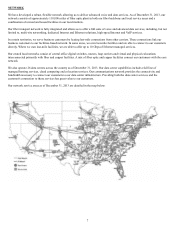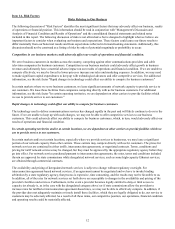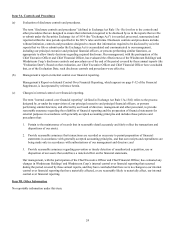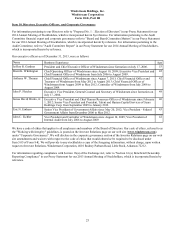Windstream 2013 Annual Report Download - page 113
Download and view the complete annual report
Please find page 113 of the 2013 Windstream annual report below. You can navigate through the pages in the report by either clicking on the pages listed below, or by using the keyword search tool below to find specific information within the annual report.15
The level of returns on our pension plan investments and changes to the actuarial assumptions used to value our pension
obligations could have a material effect on our earnings and result in material funding requirements to meet our pension
obligations.
Our pension plan invests in marketable securities, including marketable debt and equity securities denominated in foreign
currencies, which are exposed to changes in the financial markets. During 2013, the fair market value of these investments
decreased from $999.0 million to $959.7 million due to routine benefit payments of $62.8 million and lump sum payments and
administrative expenses of $23.3 million. These decreases were partially offset by the return on assets held of $10.8 million, or
1.1 percent, and a stock contribution during the third quarter of $27.8 million. Returns generated on plan assets have
historically funded a large portion of the benefits paid under our pension plan.
Funding requirements may increase as a result of a decline in the market value of plan assets, a decline in the interest rates used
to calculate the present value of future plan obligations or government regulations that increase minimum funding requirements
of the pension liability. We estimate that the long term rate of return on plan assets will be 7.0 percent, but returns below this
estimate could significantly increase our contribution requirements, which could adversely affect our cash flows from
operations. Also, reductions in discount rates directly increase our pension liability and expose us to greater funding obligations
in the future. Our earnings reported under accounting principles generally accepted in the United States ("U.S. GAAP") may
also be adversely affected due to our method of accounting for pension costs, whereby we immediately recognize gains and
losses resulting from the return on plan assets and changes in discount rates.
Our substantial debt could adversely affect our cash flow and impair our ability to raise additional capital on favorable
terms.
As of December 31, 2013, we had approximately $8,707.2 million long-term debt outstanding, including current maturities. We
may also obtain additional long-term debt to meet future financing needs or to fund potential acquisitions, subject to certain
restrictions under our existing indebtedness, which would increase our total debt. Our substantial amount of debt could have
negative consequences to our business. For example, it could:
• Increase our vulnerability to general adverse economic and industry conditions;
• Require us to dedicate a substantial portion of cash flows from operations to interest and principal payments on
outstanding debt, thereby limiting the availability of cash flow to fund future capital expenditures, working capital and
other general corporate requirements;
• Limit our flexibility in planning for, or reacting to, changes in our business and the telecommunications industry;
• Place us at a competitive disadvantage compared with competitors that have less debt; and
• Limit our ability to borrow additional funds, even when necessary to maintain adequate liquidity.
In addition, our ability to borrow funds in the future will depend in part on the satisfaction of the covenants in our credit
facilities and its other debt agreements. If we are unable to satisfy the financial covenants contained in those agreements, or are
unable to generate cash sufficient to make required debt payments, the lenders and other parties to those arrangements could
accelerate the maturity of some or all of our outstanding indebtedness.
We may not generate sufficient cash flows from operations, or have future borrowings available under our credit facilities or
from other sources sufficient to enable us to make our debt payments or to fund dividends and other liquidity needs. We may
not be able to refinance any of our debt, including our credit facilities, on commercially reasonable terms or at all. If we are
unable to make payments or refinance our debt, or obtain new financing under these circumstances, we would have to consider
other options, such as selling assets, issuing additional equity or debt, or negotiating with our lenders to restructure the
applicable debt. Our credit agreement and the indentures governing our senior notes may restrict, or market or business
conditions may limit, our ability to do some of these things on favorable terms or at all.
























